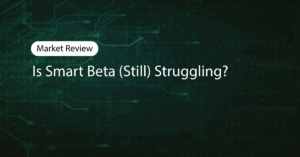Volatile Markets Put ‘Extreme Risk’ in the SpotlightMarket Review | July 2025
Introduction
Market and geopolitical events through the first half of 2025 have again highlighted the limitations of traditional volatility metrics in equity portfolios and reasserted the importance of considering extreme risk measures such as Conditional Value-at-Risk (CVaR).
The events of April 2025 exemplified the kind of tail event that volatility alone underrepresents. The peak-to-trough move in the S&P 500 stands as one of the steepest single-month drops in recent decades, with the 30.8 spike in the VIX representing a 99th percentile event. Conventional volatility-based risk models were likely to be caught off-guard by both the extent of losses and the speed of the recovery. In this Market Review, we look at recent active equity manager data through a CVaR (a.k.a. expected shortfall) lens and consider recent research on CVaR and risk-based diversification.
Key Takeaways
- There is huge dispersion in active CVaR levels of different strategies. U.S. active equity managers in the highest-CVaR quintile at end-February 2025 (before the period of greatest turbulence) had an average CVaR nearly six times greater than those in the lowest-CVaR quintile; in Europe, the figure was three times larger for the highest-CVaR quintile.
- Active CVaR levels strongly predicted relative performance during the H1 drawdown. Strategies with higher active CVaR at end-February suffered larger ‘worst-week’ losses in the three months to end-April In many cases, the worst-week relative return exceeded active CVaR: 125 out of 153 U.S. active equity funds experienced these unexpectedly large losses.
- Higher active risk diversification mitigated worst-week losses, based on high-level data from early In addition, a recent in-depth research paper has examined a longer timeframe and concluded that CVaR in equity portfolios can be lessened through risk-based diversification. Moreover, this can be done without compromising the overall degree of active risk that a manager is able to take to generate returns. The same, interestingly, is not true for holdings-based diversification.
Today’s environment featuring increased likelihood of asymmetric shocks highlights the need for investors to incorporate extreme risk measures into portfolio construction, monitoring and stress testing. Vigilant oversight can help investors to understand potential vulnerabilities, as well as consider strategic shifts that may improve resilience.
Authors
Matteo Bagnara, PhD
Quant Researcher,
Scientific Portfolio ……………………………………….
Deputy CEO and Business Development Director,
Scientific Portfolio
Read the full Market Review
"*" indicates required fields


